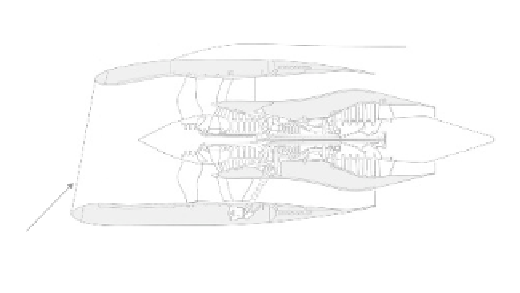Environmental Engineering Reference
In-Depth Information
Source:
Walsh, 2001
Figure 10.6
Noise reduction programmes and technologies
Research is continuing into reduced noise from aircraft engines with programmes in
both the US and Europe. The National Aeronautics and Space Administration (NASA)
has set noise reduction targets of 10dB within ten years and 20dB within 25 years.
Within Europe, a similar target has been set to reduce noise by 10dB within the next
decade and a range of European Union (EU) funded projects are currently underway.
Emissions
International limits are currently imposed for UHCs, smoke, CO and NO
x
, mea-
sured during a standardized take-off and landing cycle. At ground level, all emissions
except NO
x
have been reduced to relatively low levels. The development of the
modern combustor and its effect on NO
x
emissions is shown in Figure 10.7. Figure
10.7 also shows the legislation currently enforced for NO
x
emissions (CAEP 2). The
International Civil Aviation Organization (ICAO) and the Committee on Aviation
Environmental Protection (CAEP) have set ever tighter legislation on emissions: CAEP
1 took effect in 1986, CAEP 2 has applied to new engine types since 1996 and all
new engines manufactured from 2000, and CAEP 4 is due to take effect from 2004.
Whereas the latest international regulation accounts for high operating pressure
ratios, the local regulations in Switzerland give no consideration to those engines
operating with a high OPR. This means that at high OPR, even the newest combus-
tor design cannot meet the most stringent NO
x
production level, and will thus be
subject to landing charges at those airports. The most common combustor currently
found in engines today is the single annular combustor. The latest development, the
double annular combustor (DAC), provides a reduction in NO
x
emission of approx-
imately 12 per cent against the single annular for OPRs of between 25 and 30.
However, for higher OPRs, it appears that the current DAC can offer little in the
way of lower NO
x
.
The future of combustor developments is currently focused upon improving fuel/
air mixing prior to combustion, reducing the peak combustion temperature and thus
reducing NO
x
formation. Some of the features resulting from research aimed at the
next generation of supersonic transport are being incorporated in NO
x
reduction
programmes for subsonic aircraft. Such programmes are aiming for a 40 per cent




















































































